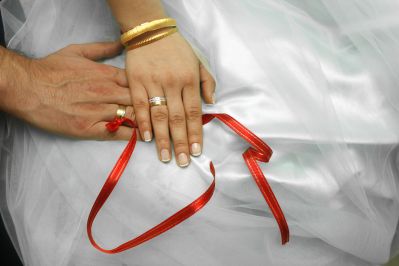 If you have friends who are Wiccan or who follow other spiritual paths, you might have already heard about the handfasting ceremony. While the exact origins of the custom are unclear, some sources suggest that it has Celtic cultural roots. Today, many modern pagans choose it as a marriage rite for both cultural and religious reasons. If you feel called by your beliefs or heritage to hold a handfasting as part of your nuptials, understanding some of its histories may help you appreciate it better. Furthermore, there are some important things to keep in mind when incorporating it into your big day.
If you have friends who are Wiccan or who follow other spiritual paths, you might have already heard about the handfasting ceremony. While the exact origins of the custom are unclear, some sources suggest that it has Celtic cultural roots. Today, many modern pagans choose it as a marriage rite for both cultural and religious reasons. If you feel called by your beliefs or heritage to hold a handfasting as part of your nuptials, understanding some of its histories may help you appreciate it better. Furthermore, there are some important things to keep in mind when incorporating it into your big day.
A Brief History of the Term
The word “handfast” may trace its beginnings to Scotland. While historical information is incomplete, writer Sharon L. Krossa offered some details on her website Medieval Scotland. Krossa cited an October 1958 article in the Scottish Historical Review revealing that the term, which may date back to the 1500s, originally meant a state of betrothal. Later, myths arose that handfasting was a form of trial marriage intended to last a year and a day, after which the couple would decide whether to make it permanent. However, no sources can confirm that this was a common practice, and it may be best relegated to the realm of rumor.
Development Into Modern Traditions
Handfasting as a marriage rite gained strength later in the 20th century. It’s not clear how the practice developed and became part of modern Celtic Neopagan wedding ceremonies. However, versions of it were documented in print beginning in the 1960s. Notably, biographer Jerry Hopkins wrote in 1980 of a handfasting ceremony involving journalist Patricia Kennealy-Morrison and Jim Morrison, the late frontman of American rock group The Doors. Kennealy-Morrison states that the ceremony occurred in June 1970. However, the marriage was never legally recognized due to the lack of a properly filed marriage license.
Today, the concept has been developed with many variations in practice. In most versions, the officiant joins the couple’s hands and ties them together with a ribbon. Other specifics included in the event can be worked out by the pair with their officiant. Several books or online sources may provide guidance as you and your beloved plan. You might be inspired to incorporate an exchange of wedding rings and write your own vows along with the joining and tying together of your hands.
Requirements for Your Marriage to Be Legal
Typically, a Neopagan clergy member will perform a handfasting. One important detail to remember is that the person officiating must have the legal recognition to do so. Some priests or priestesses from these traditions find it difficult to convince their state or local governments to give them the authority to solemnize a marriage. However, one easy solution to this problem is to become ordained through the Universal Life Church. The process can be quickly completed online. After registration, all the priest or priestess will need to do is order the necessary documentation required by the state to grant the ability to perform marriage ceremonies.
Moreover, you’ll need to make sure that other legal requirements are met for your handfasting. Most states insist that two witnesses who will sign your marriage license must be present. Additionally, you must follow other laws regarding the license application, as well as waiting periods that vary from state to state.
Tied Together in Love
While its historical roots remain murky, modern handfastings can be a poignant reflection of your heritage and your commitment to each other. It’s vital to make sure your wedding ceremony meets all legal requirements to be recognized, including an officiant who’s licensed by the state. Furthermore, you can customize your nuptials to make your handfasting a joyous celebration of your love.
Add Your Comment